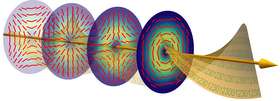Researchers use novel polarization to increase data speeds

As the world's exponentially growing demand for digital data slows the Internet and cell phone communication, City College of New York researchers may have just figured out a new way to increase its speed.
Giovanni Milione, a PhD student under City College Distinguished Professor of Science and Engineering Robert Alfano, led the pioneering experiment conducted at the University of Southern California with collaborators from Corning Incorporated, Scotland, Italy and Canada.
"Conventional methods of data transmission use light which has the fastest speed in the universe. However, these methods are being exhausted by data hungry technologies, such as, smart phones and cloud computing," said Milione. "So, we came up with an unconventional method."
Using special devices called "q-plates," the researchers manipulated a laser beam's polarization into novel shapes some of which Milione referred to as "radial" and "azimuthal." "While light's polarization (linear and circular) is used for many modern technologies, such as, 3D television, its shape is often left untouched," he said.
The researchers showed that each shape could carry an additional data stream. While the researchers used only four shapes, in principal, the number that can be used is unlimited. "The amount of data that can be transmitted on a single laser beam can be scaled to terabits or even petabits," said Alfano. "This technology is potentially compatible with building to building communication in NYC or even between Google data centers."
Their research, supported in part by DARPA, the Army Research Office, and Corning Incorporated, appears in an upcoming issue of the journal, Optics Letters.
More information: Optics Letters, www.opticsinfobase.org/ol/abst … cfm?uri=ol-40-9-1980
Journal information: Optics Letters
Provided by City College of New York




















